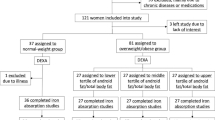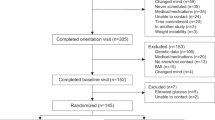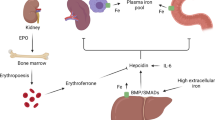Abstract
Although iron deficiency is common in women especially during dieting, weight management trials rarely examine the longitudinal impact of genetics on iron. This study examined the associations between the TMPRSS6 rs855791 polymorphism and iron indices at baseline and after a 12-month trial comparing two weight loss diets (higher-protein, higher-haem iron (HPHI) vs lower-protein, lower-haem iron (LPLI)). A total of 76 young overweight women (18–25y; BMI⩾27.5 kg/m2) were included at baseline, with 27 (HPHI: n=15; LPLI: n=12) completing the 12-month trial. At baseline, C allele homozygotes exhibited higher serum iron (P=0.047) and lower hepcidin (P=0.023) compared with T allele carriers. After 12 months, no genotypic differences were observed for ferritin and soluble transferrin receptor, although C homozygotes on HPHI showed higher serum iron and transferrin saturation (P<0.05). Results indicate that rs855791 can influence iron metabolism to some extent, but its impact on storage and functional iron status is small relative to dietary protein/iron manipulation.
This is a preview of subscription content, access via your institution
Access options
Subscribe to this journal
Receive 12 print issues and online access
$259.00 per year
only $21.58 per issue
Buy this article
- Purchase on Springer Link
- Instant access to full article PDF
Prices may be subject to local taxes which are calculated during checkout

Similar content being viewed by others
References
Tussing-Humphreys LM, Nemeth E, Fantuzzi G, Freels S, Guzman G, Holterman AX et al. Elevated systemic hepcidin and iron depletion in obese premenopausal females. Obesity 2010; 18: 1449–1456.
Cheng HL, Bryant CE, Rooney KB, Steinbeck KS, Griffin HJ, Petocz P et al. Iron, hepcidin and inflammatory status of young healthy overweight and obese women in australia. PloS One 2013; 8: e68675.
Benyamin B, Ferreira MA, Willemsen G, Gordon S, Middelberg RP, McEvoy BP et al. Common variants in TMPRSS6 are associated with iron status and erythrocyte volume. Nat Genet. 2009; 41: 1173–1175.
Traglia M, Girelli D, Biino G, Campostrini N, Corbella M, Sala C et al. Association of HFE and TMPRSS6 genetic variants with iron and erythrocyte parameters is only in part dependent on serum hepcidin concentrations. J. Med. Genet. 2011; 48: 629–634.
Oexle K, Ried JS, Hicks AA, Tanaka T, Hayward C, Bruegel M et al. Novel association to the proprotein convertase PCSK7 gene locus revealed by analysing soluble transferrin receptor (sTfR) levels. Hum Mol Genet 2011; 20: 1042–1047.
Chambers JC, Zhang W, Li Y, Sehmi J, Wass MN, Zabaneh D et al. Genome-wide association study identifies variants in TMPRSS6 associated with hemoglobin levels. Nat Genet 2009; 41: 1170–1172.
Knutson MD . Into the matrix: regulation of the iron regulatory hormone hepcidin by matriptase-2. Nutr Rev 2009; 67: 284–288.
Nai A, Pagani A, Silvestri L, Campostrini N, Corbella M, Girelli D et al. TMPRSS6 rs855791 modulates hepcidin transcription in vitro and serum hepcidin levels in normal individuals. Blood 2011; 118: 4459–4462.
Griffin HJ, Cheng HL, O’Connor HT, Rooney KB, Petocz P, Steinbeck KS . Higher protein diet for weight management in young overweight women: a 12-month randomized controlled trial. Diabetes. Obes. Metab. 2013; 15: 572–575.
Cheng HL, Griffin HJ, Bryant CE, Rooney KB, Steinbeck KS, O’Connor HT . Impact of diet and weight loss on iron and zinc status in overweight and obese young women. Asia Pac J Clin Nutr 2013; 22: 574–582.
Acknowledgements
We thank Zahra Munas and Avindra Jayewardene for their contribution to the clinical and genotyping work. A research grant supporting this work was awarded to HTO, KSS and KBR from Meat and Livestock Australia.
Author information
Authors and Affiliations
Corresponding author
Ethics declarations
Competing interests
The authors declare no conflict of interest.
Additional information
Supplementary Information accompanies this paper on European Journal of Clinical Nutrition website
Supplementary information
Rights and permissions
About this article
Cite this article
Cheng, H., Hancock, D., Rooney, K. et al. A candidate gene approach for identifying differential iron responses in young overweight women to an energy-restricted haem iron-rich diet. Eur J Clin Nutr 68, 1250–1252 (2014). https://doi.org/10.1038/ejcn.2014.82
Received:
Revised:
Accepted:
Published:
Issue Date:
DOI: https://doi.org/10.1038/ejcn.2014.82
This article is cited by
-
Matriptase as a potential biomarker and therapeutic target in newly diagnosed type 2 diabetes mellitus
Irish Journal of Medical Science (1971 -) (2023)



